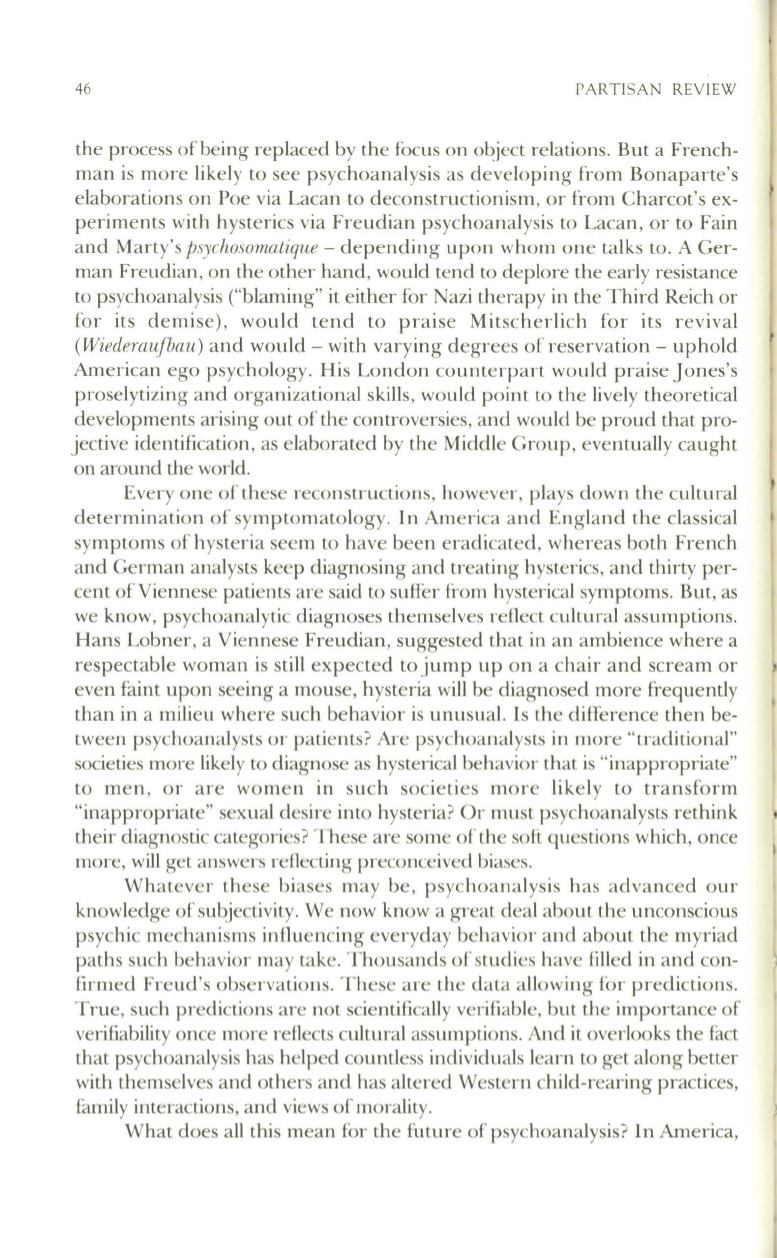
46
PARTISAN REVIEW
the process of being replaced by the focus on object relations. But a French–
man is more likely
to
see psychoanalysis as developing from Bonaparte's
elaborations on Poe via Lacan to deconstruction ism, or from Charcot's ex–
periments with hysterics via Freudian psychoanalysis to Lacan, or to Fain
and Marty's
psychosomatique
-
depending upon whom one talks
to.
A Ger–
man Freudian, on the other hand, would tend
to
deplore the early resistance
to
psychoanalysis {"blaming" it either for Nazi therapy in the Third Reich or
for its demise), would tend to praise Mitscherlich for its revival
(Wiederaufba'l1)
and would - with varying degrees of reservation - uphold
American ego psychology. His London counterpart would praise Jones's
proselytizing and organizational skills, would point to the lively theoretical
developments arising out of the controversies, and would be proud that pro–
jective identification, as elaborated by the Middle Group, eventually caught
on around the world.
Everyone of these reconstructions, however, plays down the cultural
determination of symptomatology. In America and England the classical
symptoms of hysteria seem to have been eradicated, whereas both French
and German analysts keep diagnosing and treating hysterics, and thirty per–
cent of Viennese patients are said to suffer from hysterical symptoms. But, as
we know, psychoanalytic diagnoses themselves reflect cultural assumptions.
Hans Lobner, a Viennese Freudian, suggested that in an ambience where a
respectable woman is still expected to jump up on a chair and scream or
even faint upon seeing a mouse, hysteria will be diagnosed more frequently
than in a milieu where such behavior is unusual. Is the difference then be–
tween psychoanalysts or patients? Are psychoanalysts in more "traditional"
societies more likely to diagnose as hysterical behavior that is "inappropriate"
to men, or are women in such societies more likely to transform
"inappropriate" sexual desire into hysteria? Or must psychoanalysts rethink
their diagnostic categories? These are some of the soft questions which, once
more, will get answers reflecting preconceived biases.
Whatever these biases may be, psychoanalysis has advanced our
knowledge of subjectivity. We now know a great deal about the unconscious
psychic mechanisms intluencing everyday behavior and about the myriad
paths such behavior may take. Thousands of studies have filled in and con–
firmed Freud's observations. These are the data allowing for predictions.
True, such predictions are not scientifically verifiable, but the importance of
verifiability once more reflects cultural assumptions. And it overlooks the fact
that psychoanalysis has helped countless individuals learn to get along better
with themselves and others and has altered Western child-rearing practices,
family interactions, and views of morality.
What does all this mean for the future of psychoanalysis? In America,


